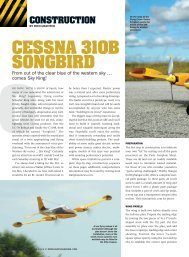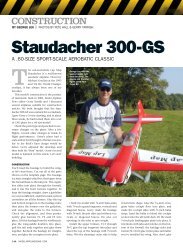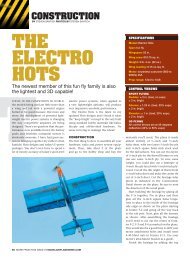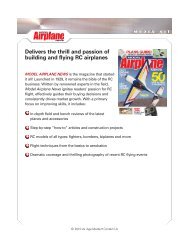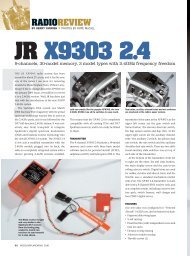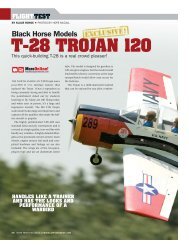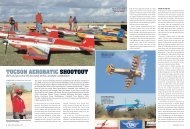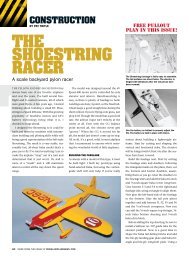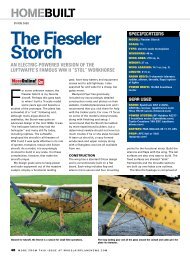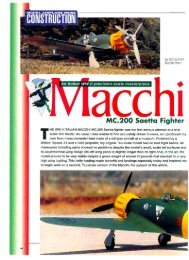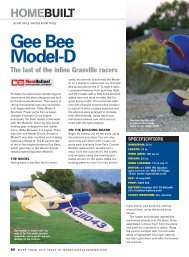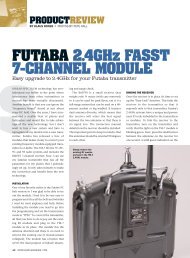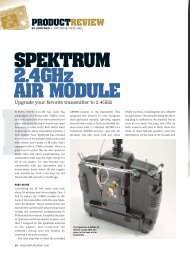Create successful ePaper yourself
Turn your PDF publications into a flip-book with our unique Google optimized e-Paper software.
RPM<br />
Using the needle in the carb helped, but not much. Frustrated, I<br />
gave up; the Cub has been hanging in my garage ever since!<br />
After reading your article in the November 2001 issue of Model<br />
Airplane News concerning proper break-in, I purchased a test<br />
stand, hoping to figure out the problem with the 1.48, but I didn't.<br />
Before I ran the engine on the test stand, it had about 20 ounces<br />
of fuel through it. I was finally able to get the engine running at<br />
a rich four-cycle, but it took seven (!) turns to the rich side on<br />
the needle valve. This seems excessive. I've tried the old trick of<br />
using a small piece of fuel line around the needle valve to eliminate<br />
air leaks, but that didn't work either. When I go from seven<br />
to six turns out, the engine runs at peak rpm; there is no<br />
adjustability. I've considered replacing the carb but have no idea<br />
what to replace it with."<br />
Tom, it's a shame that you've had all this trouble with the MDS<br />
1.48 2-stroke engine; it seems like a good match for the Cub.<br />
The first thing that comes to mind is, what size fuel line are you<br />
using? You didn't say in your letter. Is it the large variety or the<br />
medium? If the latter, I suggest that you change to the larger<br />
size. Fuel-flow rates can exceed 2 ounces per minute at a rich<br />
"four-cycling" mode of operation with this engine, and that's a<br />
lot of flow for medium-size fuel line.<br />
Another possible cause of the problem is a restriction within<br />
the carburetor itself. A piece of flashing or a chip from manufacturing<br />
processes could be lodged somewhere within the metering<br />
jet tube. Remove the carb from the engine and carefully disassemble<br />
it, looking closely at the jet and idle-needle<br />
assembly/interface. With the primary needle valve removed,<br />
blow air or force fuel through the spraybar with a fuel<br />
bulb/syringe to see whether it behaves as if it's restricted. Try<br />
running a piece of small diameter music wire, or a pipe cleaner,<br />
through the spraybar.<br />
Last, make certain that the carb is tightly sealed to the<br />
neck of the crankcase; even a small air leak can lean a<br />
fuel mixture in a hurry.<br />
NEW BEARINGS FOR A MOKI<br />
D. Gibbs emails: "I have a three-year-old Moki<br />
1.8. It starts very easily, runs very reliably and<br />
has plenty of power. In mid-flight the other<br />
day, however, the engine stopped. The front<br />
[ball] bearing had failed, and a small piece of<br />
steel from the failed bearing had lodged at the<br />
very front of the crankcase housing, between<br />
it and the crankshaft. This caused only very<br />
minor damage to the housing, just behind<br />
the front bearing, and didn't damage the<br />
crankshaft at all. Using 600-grit wet/dry abrasive<br />
paper and some mild detergent mixed<br />
Ball bearings for crankshaft<br />
with water for lubrication, I was able to support—front and rear.<br />
completely clean up the inside of the<br />
housing. The large, rear ball bearing seems fine, but I figured<br />
that while I had the crankcase housing unbolted from the<br />
crankcase, I would change out both bearings. I had previously<br />
acquired replacement bearings from a local supplier, but unlike<br />
the unsealed originals, these are sealed. The new bearings are<br />
good-quality units from SKF. Would it be all right to replace the<br />
old bearings with the sealed units? Does it make a difference?"<br />
Mr. Gibbs, the seals on your replacement bearings won't hurt a<br />
114 MDDEL AIRPLANE NEW5<br />
thing, so install them as is; the grease will simply wash out during<br />
engine operation. If you don't like the slight frictional drag<br />
that the seals produce, simply remove them. Pry them from<br />
their seats with a tiny slot-type screwdriver (such as those used<br />
by jewelers), or use a hobby knife with a no. 11 blade. Don't<br />
touch (and possibly damage) the balls in the process (unlikely,<br />
since you'll be careful!). You can then wash out the grease with<br />
a solvent; I like to use lacquer thinner because it doesn't attract<br />
rust-producing water from the air (caused by hygroscopic<br />
action, as occurs with alcohol). Allow the bearings to dry naturally.<br />
Don't use compressed air to hasten drying; dirt in the<br />
airstream could contaminate the bearing assembly. Lubricate<br />
them with Marvel Mystery Oil and install them in your Moki.<br />
OLDER FOX ENGINES<br />
Mr. B. Jackson of Burlington, Ontario, Canada, writes: "I purchased<br />
four old Fox engines, including an early .78 with an<br />
exhaust baffle coupled to the carburetor. Two Fox .36s and a Fox<br />
.29 completed my find; all engines are new in the box! When I<br />
told my fellow club members that I was going to use one of the<br />
.36s in a Balsa USA Stick 40, they told me that Fox .29s and .36s<br />
were hard to start, the carburetors were difficult to adjust, and<br />
they really vibrate—especially in a lightly constructed model<br />
such as the Stick 40. They also informed me that the Fox .29<br />
and .36 require a minimum of 15-percent nitromethane in the<br />
fuel. Can you tell me how much of this information is fact and<br />
how much is fiction?"<br />
Mr. Jackson, it sounds as though your Fox .29 and .36s are<br />
equipped with cast-iron pistons and steel cylinders. This combination<br />
required several hours of patient break-in before the iron and<br />
steel were "bedded-in" and heat-cycle stress relief was achieved.<br />
The break-in fuel was very important to the "iron Fox"; it required<br />
a minimum of 25-percent castor oil (preferably 28 percent, with<br />
a low nitromethane percentage—about 5 percent).<br />
Although the Fox instructions were clearly written,<br />
many modelers ignored them and tried to fly the<br />
engine right out of the box; this never worked and<br />
gave rise to the problems described by your club<br />
members. In my opinion, this was not the fault of<br />
the manufacturer or the engine. Properly broken in,<br />
Fox engines are great runners.<br />
In reference to Fox carburetors, I'd like to note<br />
that Duke Fox produced more carburetor designs<br />
than any other manufacturer during the '60s and '70s.<br />
Another prolific producer of carb designs, SuperTigre, had to<br />
take a back seat to Fox in this arena. On at least one occasion,<br />
Peter Chinn (past engine columnist for Model Airplane<br />
News) was diligently trying to explain the workings of a<br />
recently released Fox carburetor while Duke Fox was promoting<br />
a newer version in an ad in the same issue!<br />
With proper break-in and fuel (5- to 10-percent nitro is<br />
plenty), Fox R/C .29s and .36s are easy to start, smooth running<br />
and very throttleable—if the owner follows Duke's detailed<br />
instructions. As an added benefit, a properly maintained "iron<br />
Fox" will run and last forever.<br />
Klotz Special Formula Products Inc., 7424 Freedom Way, Fort<br />
Wayne, IN 46817; (800) 242-0489; fax (219) 490-0490;<br />
www.klotzlube.com.



